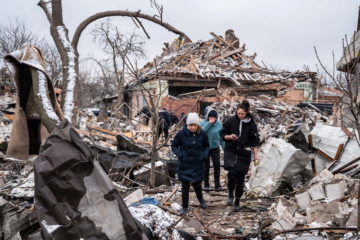by Varun Gauri

When the Federal Reserve Bank raises interest rates to fight inflation, rates rise worldwide, and debts in developing countries become more difficult to service. The consequences for low-income countries can be severe. For instance, When Paul Volcker decided in the early 1980s to push the prime rate over 20%, he triggered a debt crisis in the developing world, causing catastrophic unemployment and poverty. The impact on Latin America exceeded that of the Great Depression, and was by some measures the worst financial disaster the world has ever seen. The ensuing cascade of poverty across Africa coincided with the emerging HIV/AIDS crisis, causing widespread misery. For instance, life expectancy, usually rising in the modern world, went, in Zimbabwe, from 61 years in 1984 to 48 years in 1997 (the interest rate shock was not the only cause). As historians note, a similar dynamic had played out in the 1920s, when the world’s main central banks raised interest rates, causing the price of grains and energy to become unaffordable for millions in colonies and low-income countries.
The practice continues. Recently, the covid pandemic, inflation, and the Russian invasion of Ukraine have pushed an estimated 75 million people into poverty. In this context, the Fed has been raising interest rates to bring down a mix of demand-led inflation, rooted in sectoral imbalances following the covid crisis, and supply-shock inflation, arising from the Russian invasion of Ukraine. The Fed’s aggressiveness is perilous for the poorest people in the world, and the warning signs of developing country debt crises are again flashing.
Sri Lanka and Ghana have already defaulted on sovereign debt, and others may follow. The debt servicing cost of public debt in low-income countries is already above 10% of government revenue, on average, the highest it’s been in a decade. The average growth rate for developing economies is projected to drop below 3%. Slowing economies and rising poverty, rising domestic inflation associated with currency devaluation, and cuts in health care, education, and social services will likely send millions more people into poverty. Many will die.
Are there alternatives to aggressive interest rate hikes? Can governments control inflation in other ways? And if there are no viable alternatives, might the Fed at least try to mitigate the damage it inflicts on the poorest people in the world, those living in extremely vulnerable circumstances?
The truth is no one knows. The reason no one knows is that few, if any, central banks in the financial capitals view global poverty as part of their mission. In the early postwar years, some countries had something like a social norm of voluntary wage and price controls. When inflation was a concern, government-convened conversations between business and labor sometimes led both groups to give up wage and price demands for the common good. That was an alternative to aggressive interest rate policies. Could there be ways to revive that social norm? If not, then perhaps the Fed itself could take steps to reduce, if not eliminate, its civilian casualties. For instance, the Fed currently has swap agreements with systematically important central banks, designed to inject liquidity during crises. Why not expand those to include central banks in low-income and more middle-income countries, who suffer so much from the Fed’s policies?
You might be thinking: But global poverty is not the job of the Fed, whose mandate is domestic. The Fed is supposed to control inflation and reduce unemployment in America. I don’t think that’s a sufficient answer. No one doubts the mission of the Pentagon is to promote and defend the American national interest. Still, everyone (including the Pentagon itself) believes it should take steps to mitigate civilian casualties. The Secretary of Defense is obligated to submit an annual report on to congress on the civilian casualties caused as a result of United States military operations. The Department of Defense calls the mitigation of civilian harm during armed conflict “a strategic and moral imperative,” and is developing response plans (and perhaps a new office) to systematize its approach to civilian harm mitigation. The plans require military personnel to consider potential harm to civilians in any airstrike, ground raid, or other type of combat.
Note that this acknowledgment of responsibility for mitigating civilian deaths in combat does not hide behind arguments that civilians are themselves the cause of the harms they suffer (e.g., those people should’ve voted for a better government, they shouldn’t be so sympathetic to terrorists, why were they wandering around outside during wartime, if the US armed forces didn’t engage many of those civilians would’ve died at the hands of their own government anyway). Similarly, arguments that the poorest people in the world are themselves responsible for debt crises and associated harms (e.g., those people should’ve voted for less corrupt governments that didn’t go on borrowing binges, many would’ve died anyway from their governments’ bad policies), are also irrelevant to the Fed’s responsibility to take steps to mitigate misery associated with aggressive interest rate policies.
We know, both from economics and history, that the Fed’s actions will cause civilian deaths. Perhaps ideally, international institutions like the World Bank and the IMF would have the resources to help low-income countries manage the shocks. But those institutions are not sufficiently resourced. That is not the world we live in. The Fed’s actions predictably harm the poorest people in the world, pushing many to the edge of life and death. That fact alone imposes a moral responsibility to reduce the civilian casualties arising from its policies.
